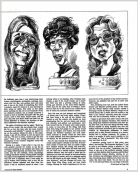“I never set out to start a women’s revolution. I never planned it. It just happened, I would say, by some miracle of convergence of my life and history, serendipity, one thing leading to another” (Friedan, 2000, p. 13). Betty Friedan was born in February of 1921, just six months after the 19th Amendment granted all American women the right to vote. She is the author of multiple novels—most notably The Feminine Mystique which was published in 1963. This novel radicalised the way women thought of their femininity and what it truly meant to be a woman who was equal in American society.
Friedan grew up in Peoria, Illinois during the depression, which led to many monetary struggles within her family; causing secrets to build up and walls to grow around her heart and emotions. She saw how her mother’s emotions ruled her household and prayed that one day she would have a career like her father. Throughout primary and secondary school, Friedan was a talented writer, winning multiple contests and awards and bonding with her father over literary works and philosophers, but that bond later died out. As she grew older, she looked towards icons to find a sense of community that her siblings found with their friends. Invitations to collaborate with peers and higher-ups at Ivy-Leagues, the Smith paper, and eventually the American Youth Congress, helped Friedan to develop a deeper connection with writing, editing and voicing her opinion on controversial matters.
“I was no feminist, don’t remember even studing the battle for the women’s vote, only knew of sufferattes, with my new Freudian sophistication, as neurotic spinsters suffering from penis envy” (Friedan, 2000, p. 41). However, marriage, motherhood and mystique led her down a path she had not considered while attending college. Fieidan reunited with many former classmates fifteen years post-graduation from Smith College and embarked on a journey of conducting interviews to better understand their contentment, or mostly lack thereof, with the current expectations of American women (Michals, 2017, par. 5). These interviews later led to the literary works that we now know as The Feminine Mystique. She dubs the inequality of men and women as “the problem that has no name” as the major theme within the book. The nonfiction writing ends with: “We can no longer ignore that voice within women that says: “I want more than my husband and my children and my home” (Friedan, 1963, p. 32). Women were not helpless housewives only created to fulfill men’s simple everyday and extravagant sexual pleasures, but to establish their own wants and needs separate from maternal expectations. The movement towards a generation of women finding their voices seemed more promising with this new foundation under their feet. Friedan articulated the problem that had the majority of women questioning their fulfillment for decades and consequently became the spokeswoman for women’s equality and she later co-founded the National Organization for Women.
Friedan, B. (1963). The feminine mystique. DELL PUBL. CO.
Friedan, B. (2000). Life so far. Simon & Schuster Paperbacks.
Michals, D. (Ed.). (2017). Betty Friedan. National Women's History Museum. Retrieved November 17, 2021, from www.womenshistory.org/educatio…...

